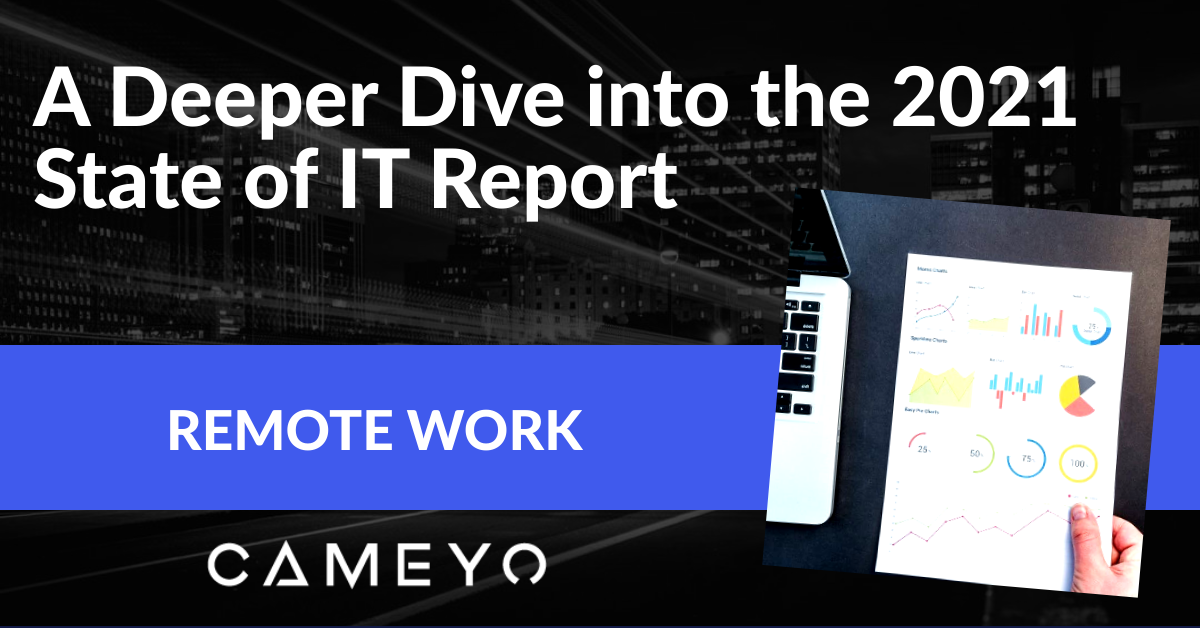In case you missed it, Spiceworks and Ziff Davis B2B (SWZD) recently released their 2021 State of IT report. Compiled on the strength of comprehensive surveys with IT professionals and CTOs, it’s packed with a ton of valuable and eye-opening info on IT budgets and priorities.
The results of the report indicate how trends like remote work, digital workspaces and working from home are continuing to evolve—not just in response to COVID-19 but also to ongoing seismic shifts in the workplace.
In this post, we’ll take a deeper dive into some of The State of IT report’s most intriguing aspects.
A 55% increase in VDI signal volume
Back in March, virtual desktop infrastructure (VDI) saw a 55% increase in signal volume, a metric that captures interest and actionable intent toward a given solution. This surge in interest in VDI was second only to videoconferencing (60%).
What explains that surge? At the start of the pandemic, companies were scrambling to find whatever immediate solutions they could to facilitate remote work. In many cases organizations landed on utilizing VDI, simply because it was familiar. Most knew that it wasn’t a feasible long-term solution for their whole organization based on the complexity & cost, but they assumed they could rely on it for a couple of months and then trim it back down once the trouble blew over.
But as we know, that didn’t happen. So a lot of organizations found themselves faced with the prospect of supporting expensive, complex virtual desktop infrastructure into 2021 and beyond.
Since then, those organizations have adjusted for the long-term and shifted to more streamlined solutions like updated approaches to application virtualization. While VDI & DaaS are great solutions for people who truly need access to a full virtual desktop environment, they are overkill for the majority of people in an organization who just need simple, secure access to all of their business-critical apps on any device, from the browser. For that segment of your users, virtual application delivery can be more secure, less complex and more cost-effective for enabling productivity among remote and work-from-home (WFH) employees.
New drivers of IT budget increases
Even if the worst of the pandemic ends up being confined to 2020, its effects will continue to be felt for quite some time. In its “Drivers of IT Budget Increases” section, the State of IT report includes two completely new categories to account for this:
- Changes to business operations during COVID-19
- Supporting the remote workforce during COVID-19
Both of these changes are clearly going to impact IT spending in the near term. In fact, 38% of organizations who said they were increasing IT budgets next year cited COVID-related changes to business operations as a reason for doing so. Nearly the same amount—36%—said the same for supporting their remote workers.
What’s revealing is that, compared to small businesses, roughly twice as many mid-size and enterprise organizations responded in this way for each category. That illustrates the disproportionate effect that the size of the remote workforce has on the budget. It also highlights the need to find flexible solutions that can scale affordably from 100 digital workspaces to 10,000+.
Changing priorities are changing technology adoption
Among some businesses, The State of IT report found less enthusiasm for cutting-edge technology. For example, there was a lot of anticipation for Gigabit Wi-Fi networking last year, but it’s since dropped to 2018 levels. Pandemic-related reprioritization is the reason for that.
One area that saw a slight jump is virtual desktop infrastructure, which inched upward to a 46% current or planned adoption rate. Prior to the pandemic, Spiceworks pegged VDI adoption at 44% in its 2020 State of Virtualization Technology report. In the more recent survey, 26% of businesses said that their expanded VDI deployment was due to COVID.
According to those same stats:
- 51% of large (5,000+) enterprises are already using VDI. Another 25% are planning to implement it within the next two years.
- For organizations in the next size tier (1,000–4,999 employees), 38% are currently using VDI. A further 31% are looking to adopt it.
Though it’s possible that the SWZD report doesn’t take the trouble to distinguish between VDI and virtual application delivery, instead choosing to put all “virtual” solutions under the same umbrella, there are fundamental differences between these approaches to digital workspaces. It doesn’t just come down to ease of deployment and lower costs. It also has to do with their security.
Hardening the IT environment—inside and outside the workplace
Regarding security, The 2021 State of IT report has this to say:
“The massive shift to remote work has seen employees around the globe taking corporate devices and data outside of the relatively safe confines of corporate networks. This has sparked many concerns, particularly regarding endpoint device security, vulnerability management, detection of security events, and security incident response.”
Any embrace of conventional VDI seems to be at odds with attitudes toward endpoint device security, which IT professionals listed as their top concern for their remote workforce. Along with being more costly and cumbersome, using virtual desktop infrastructure as a platform for digital workspaces potentially broadens the IT attack surface.
Application virtualization, by contrast, can provide streamlined access to business-critical software without the task of overseeing a dedicated subset of IT infrastructure.
For example, virtual application delivery with Cameyo lets remote users run Windows applications right from their browser. They benefit from the seamless productivity of using essential Windows desktop software on any device. Meanwhile, IT can easily control their access on an app-by-app basis—and without the need for VPNs. That’s why Baldwinsville Central School District in New York described Cameyo as having “multiple layers of security truly baked in at the foundation,” unlike VDI.
To make your organization’s transition to remote work quick, smooth and secure, and without breaking the IT budget, get started today with a free trial of Cameyo.
